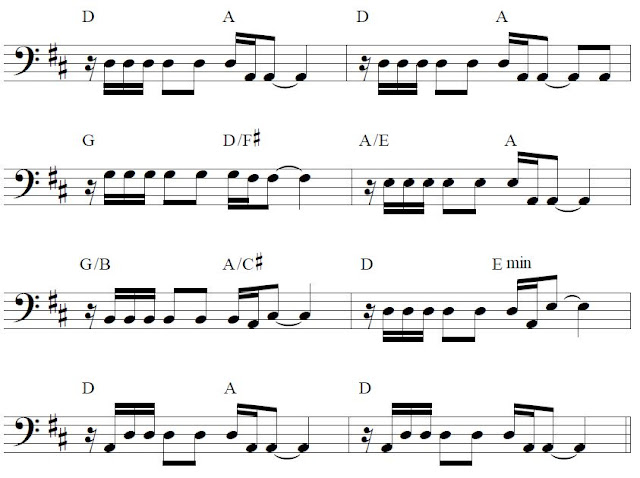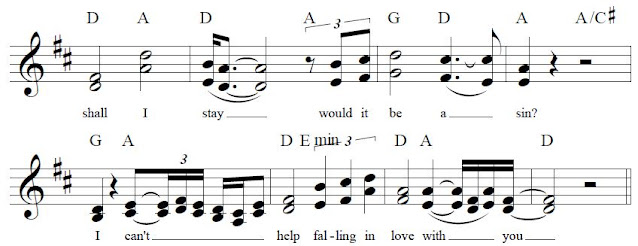Chances are you don't remember the plot of the movie "Sliver," starring Sharon Stone, William Baldwin and Tom Berenger. You do, however, probably remember the song "Can't Help Falling In Love With You." What lineage....a French love song, "Plaisir D'Amour," composed by a German composer, Jean-Paul Egide Martini (!?!?) in 1784, rewritten in 1961 by George Weiss and company ("Lion Sleeps Tonight," "What A Wonderful World") and recorded by Elvis Presley, only to make it to no.2 on the Billboard Hot 100 in February of 1962. [1]
Fast forward to 1993. On the heels of many other popular versions of the tune, UB40's pop-reggae version climbs to no.1 in the U.S., the British group's second no.1. [2] The path of this song's no.1 journey is interesting and is reflected in the musical analysis. This is the oldest source material I can recall appearing on the Hot 100. George Weiss, a master songsmith, brings this melody to life in an accessible way for pop audiences.
July 24th - September 4th, 1993: "Can't Help Falling In Love" by UB40 lasts 7 weeks at no.1!
The form to this song is very peculiar, in terms of standard pop music forms. The intro is really a statement of the "verse" and "chorus," or A and B. We get an 8 measure verse with vocals and organ laying down the chords. We then get an instrumental statement of the 5 measure "chorus."
The "verse" and "chorus" don't quite feel like traditional because each verse contains the lyrical refrain: "I can't help falling in love with you." The verse is better labeled as an A section and is the primary repeated motif throughout the tune. The "chorus" is only labeled as such due to repeated lyrics. It fills the role of a B section, or contrast to the A section. There is no bridge, so this section almost pulls double duty as repeated "chorus" material as well as the bridge like function, contrasting the A section.
This B section is also an unusual 5 measures long. It doesn't sound out of place though and the chord resolutions feel natural.
The final measures tag the refrain and then fade out. The repetition of the hook to close out the song helps give the song a classic shape, even if the other sections fall outside of that shape earlier in the song.
Chord Progressions
George Weiss successfully took an antique melody and gave it a makeover with contemporary harmony.
The intro outlines a straightforward chord progression:
I V/ I V/ IV I / V / IV V/ I IV / I V / I
Lots of I-V resolutions with plenty subdominant color added in.
When we get into the verse, the bass line colors this progression up a bit more:
 |
| Verse - Bass Line |
Aside from all the slash chords, the only real change is an E minor replacing the G. Subbing out a vi for a IV is common sub. I do love this bass line. It is a solid example of the reggae style and features some great root motion through the slash chords.
The bassline is accompanied by several layers that fill out the harmony. Synthy pads lay out the chords over the top while the piano/guitar plays a classic reggae upbeats rhythm pattern.
 |
| Chord Rhythm |
The chorus takes the standard progression and swerves quite a bit.
iii VI / iii VI/ iii VI / ii / IV V
The motion from iii to VI gives this section a completely different feel, taking us out of the diatonic realm by one note (D#). The turnaround back to D blurs the tonality with the Emin11/A. The chords chunk out Emin while the horns add in A, B and D, over the bass A.
To further intensify this, the bassline plays C# over the F#min chord and changes the rhythmic approach, adding in these syncopated drops in the first three measures. In the last two bars, more consistent rhythm propels things right back into the verse.
 |
| Chorus - Bass Line |
The tag ends the song on the last 4 bars of the verse.
Melody
When I first listened to the tune, I remember thinking "this should be a fairly cut and dry melody transcription." Man, was I wrong. The pitches were mostly easy to pin down, but the rhythm presented a real challenge. Ali Campbell's vocal delivery is so loose and relaxed that he is often way behind the beat. This causes off beat syncopation to come off as triplets, further confused by the fact that he sings purposeful triplets some of the time.
We get a feel for this right at the top with the organ and voice duet:
 |
| Intro (Verse) - meas. 1-8 |
The entire melody features chord tones, except for bar 6. This is the bar that becomes E minor after the band kicks in, pronounced by the bass. E minor and G, of course, are basically the same chord. Without the bass though, it feels like a G here in the intro.
Ali Campbell seems to be a fan of the whole step above resolving to chord tone, which happens 3 times (meas. 2 3, and 7).
During the following verses, the melody is harmonized. The harmony jumps around a bit, covering a 3rd higher, then a 4th, then moving in parallel 5ths. The differing timbres and intervals result in a pleasant sound filled with character. A cool ornament happens in measure 5, another example of the rhythmic fluidity the singers wade through.
 |
| Verse 2 |
The final verse before the tag has a stuttered vocal figure that may or may not have been purposeful. Either way, it varies the repetitive verse and helps makes the last, repeated verse feel slightly different.
 |
| Verse 3, second time, meas. 1-4 |
 |
| Chorus Melody with Horns |
 |
| Tag Ending - Melody and Horns |
The horns certainly fill up the space left by the vocals. The thirty second note figure almost answers the triplet vocal melody in fast succession. They stay on the A, holding back the D major resting place until the next bar. There, they double the bass line. After hearing that bass line throughout the entire tune, it sounds natural when the horns double it, even though the line is very busy and highly syncopated. It ends the tune in grand fashion as it fades out.
The river flows to the sea and then disappears? The river flows into the sea and they become one? The fate of the protagonist is unclear. Thanks to the Words And Music And Stories blog for bringing some of these points to light.....it will certainly help me think twice about this song the next time I hear it at a wedding. [3]
Aside from the mixed messages, the rhyme scheme is non existent. In the verse, none of the lines rhyme. Instead, there is some vowel consonance on "wise" and "I," and not as lined up with "fool" and "you." Coincidentally, the first and second verses have the same vowel construction with "say" and "stay," and "in" and "sin." The third verse does not follow suit.
The chorus follows an ABAB rhyme scheme with: "flows; sea" and "goes; be."
It is a little surprising how few lyrics there actually are. Excluding the tag, there are 131 syllables in the main body of "Can't Help Falling In Love.". 34% of them are made up of "I can't help falling in love with you." If you take the repeated tag into consideration, that goes up considerably. It's amazing that more than 1/3 of the entire lyrical content is the hook.
Common Threads
Repetitive Melody - Absolutely. The refrain checks this box in bold.
When this song came out in 1993, I remember despising it. Granted, I was just starting out on a lifelong obsession with heavy metal, in particular, Megadeth. In my early days of watching MTV, I remember watching this video and desperately hoping for something with more edge to follow. With fresh ears, I like this song quite a bit.
Up next time, "on the 3's" rolls on with a stop in 1983. July 9th - August 27th, 1983. 8 weeks at no.1...."Every Breath You Take" by The Police dominates the no.1 position on the Billboard Hot 100. Awesome. I am a big admirer of The Police and Sting, in particular. I also know this song made a resurgence in the 2000's. This should be a fun one. Stay tuned!
[1]https://www.songfacts.com/facts/elvis-presley/cant-help-falling-in-love
[2]https://ig.ft.com/life-of-a-song/can't-help-falling-in-love.html
[3]https://wordsmusicandstories.wordpress.com/2019/03/27/cant-help-falling-in-love-2-analysis/
